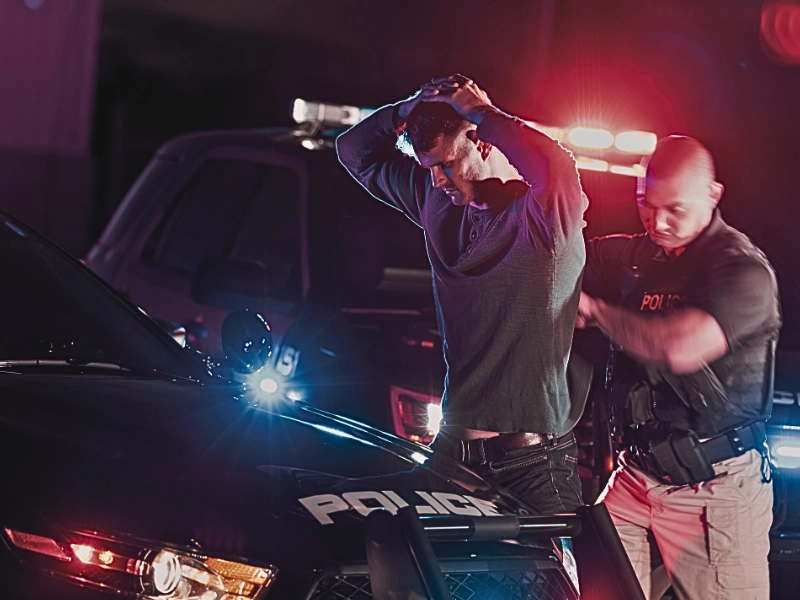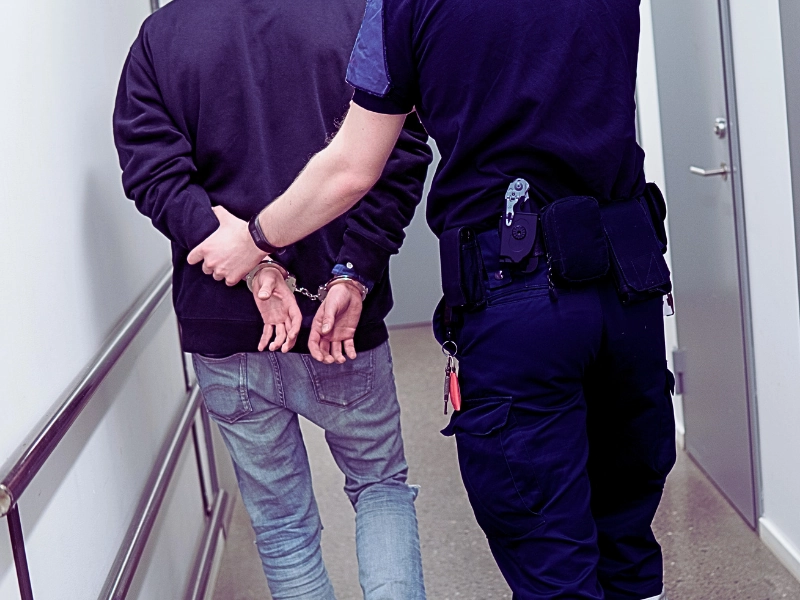No matter who is at fault, you may face misdemeanor or felony charges for fleeing the scene of an accident in Minnesota. These charges carry up to a $5,000 fine and jail time of up to three years. The charges for a hit-and-run offense depend on the injury’s severity, with accidents that result in fatalities carrying harsher penalties.

Many people think they avoid these charges by fleeing an accident scene. However, the reality is that fleeing the scene attracts even more punitive penalties. Besides the jail time and fine, loss of driver’s license, trouble securing a job, and revocation of firearm possession rights are other consequences of fleeing the accident scene.
Table of Contents
What Are Hit-and-Run Accidents?
A hit-and-run crash happens when a driver causes a collision and drives off without providing insurance or contact details. Hitting and running is a serious traffic offense that can become a felony if it ends in life-threatening injuries or death. Thus, you should know what to do if you get into an accident.
Besides qualifying as a criminal offense, fleeing an accident scene is also considered unethical. That is why offenders often lose firearm possession rights. It shows that you do not take responsibility for your actions and have little or no regard for other people’s safety.
Thousands of hit-and-run accidents happen in Minnesota. In 2021, the state recorded 7,532 hit-and-run cases, representing about 12% of all road crashes reported.
Nationwide, the highest numbers were recorded in 2015, when the total number of hit-and-run accidents was 737,100. The 2015 national statistics imply that a hit-and-run crash happened somewhere in the U.S. every 43 seconds throughout the year. The number of fatalities from the hit-and-run accidents reported was 2,049, the highest ever in a year.
Now, the question many ask is why drivers choose to flee a hit-and-run accident scene. Well, most drivers who flee are uninsured, unlicensed, have a warrant, or are intoxicated. The previous years’ statistics showed that states with more uninsured drivers reported a high number of hit-and-run accidents.
What Is Minnesota’s Hit and Run Law?
Minnesota has a strict hit-and-run law that, among other things, outlaws fleeing an accident scene after a collision. The law requires you to check if the other party is injured, even if you are not at fault for an accident. You also need to provide the other person with appropriate aid, including calling in for medical care if that person is injured.
You are responsible for calling and informing the police of the accident. Once the police arrive, help officers examine the scene and provide any information they may ask from you. If the car you hit is unattended, you must try contacting the owner and informing the police, even if no one was injured.
According to Minnesota’s hit-and-run law, you must remain at the scene until emergency teams arrive. If you are at fault and flee the scene, authorities have the right to charge you. If you have made genuine attempts to reach out to the owner of an attended car, you have the right to leave.
However, you still need to report the accident to the police. Ensure you provide the police officers with the car registration and your insurance details. The law allows you up to 72 hours to report an accident involving an unattended vehicle. Failure to report within that time may attract serious criminal charges.
There are two options when it comes to hit-and-run accident charges. These offenses can either become felonies or misdemeanors. A hit-and-run accident becomes a misdemeanor if it only ends in property damage. However, it can become a felony if it ends in permanent body injuries or the death of a victim.
Misdemeanor Charges
A hit-and-run accident that does not cause any injuries is considered less serious. If you are at fault, you will pay up to $1,000 in fines or serve a jail term of up to 90 days, or both. However, if the accident leads to personal injuries, the fines will go up to $3,000, and you may serve a jail term of up to one year or both.
Felony Charges
A hit-and-run accident that ends in severe body injuries, organ loss, and permanent disfigurement is considered a felony. It attracts up to $4,000 in fines and a jail term of up to two years. However, if the accident leads to death, the fine increases to $5,000 and the jail term to three years or sometimes both.
Your case will be more serious if it gets classified as a felony. Fortunately, however, a felony lawyer familiar with Minnesota’s hit-and-run laws can dig into your case and devise strategies for getting the charges reduced or dropped altogether.
What to Do After a Hit-and-Run Accident
The moments after a hit-and-run accident can be confusing and frightening. Most people do not know the exact steps to take, and that is when the thoughts of fleeing the scene cross their minds. However, there are procedures that drivers must follow after getting into an auto accident. These steps include but are not limited to the following:
Calling for Medical Help
You should ensure everyone is safe before taking any action. Thus, the first step is to call for medical help. Providing first aid while waiting for the medical team to arrive is also advisable. Do not skip this step, even if no one bears physical injuries because the victims may have serious internal injuries.
Report to the Police
The next step should be reporting the accident to the police. In most cases, the police will be on their way with the medical team. However, be sure to call to confirm that they are on their way. Once they arrive, they will assess the scene, gather information, and later write their report.
Gather Evidence
Although the police will gather evidence at the scene, more is needed. You need to gather any evidence that you can. For instance, it will help to take detailed pictures and record videos of the debris. The evidence you gather will help your attorney build a solid argument that will help you win the lawsuit.
Inform Your Insurance Company
You should ensure your insurance company knows about the accident. Notifying your insurer will make it easy to compensate the damages if the victim files a claim against you. Also, provide the insurance company with as much information as possible to help those responsible expedite the claim and speed up your case.
Why Do Drivers Flee Hit-and-Run Accident Scenes?
Most drivers flee accident scenes because they are uninsured. However, there are other reasons for this. Knowing them will help you prepare well to avoid fleeing a scene.
Here are other common reasons:
- Having a DWI history that has led to the suspension of your driver’s license
- Driving under the influence when the accident happened
- An undocumented immigrant may flee the accident scene for fear of deportation
- Having active warrants and fearing arrest
These reasons can cause a driver to flee a hit-and-run accident scene. However, whether uninsured, unlicensed, or driving under the influence, fleeing the scene can only worsen the situation.
Consequences for Fleeing the Scene of an Accident
You might wonder what will happen if you leave or flee the accident scene. Some possible consequences of fleeing the accident scene include:
Loss of Drivers’ License
You might be denied driving privileges if you flee an accident scene. Sometimes your driver’s license will be suspended for a period that the court will determine, depending on your driving record and the unique circumstances of your case. However, the court also holds the right to revoke a driver’s license.
Revocation of Firearm License
You might not convince the court to trust you with a firearm if you cannot remain at the scene of an accident you caused. If you are at fault and choose to flee, leaving the casualties to their means, your offense is a felony. Such a level of conviction allows the court to revoke your right to own a gun.
Loss of Voting Rights
Vehicular manslaughter, which means causing death in a car accident, is a felony offense. A charge of this magnitude could lead to an individual getting denied certain civil rights. One of the rights the court may deny you is the right to vote and serve on a jury anywhere in Minnesota.
Difficulty Retaining or Obtaining Employment
You may be in trouble if your job requires a professional driver’s license and you have been involved in a hit-and-run accident. The court may suspend your license, making you ineligible to be a professional driver. Besides, most employers may not hire you if they discover a hit-and-run arrest, charge, or conviction in your record.
Will Your Insurer Cover the Costs of a Hit-And-Run Accident?
People involved in hit-and-run accidents often wonder whether their insurance providers will cover the costs arising from the accident. Insurance companies cover the other party’s injury and vehicle damage costs if their client is at fault. However, they only do this up to their client’s policy limit. Thus, you may have out-of-pocket costs to cover if the costs exceed your limit.
What happens if you are the victim in a hit-and-run accident? The first factor to consider is if the driver at fault has enough insurance to cover the costs. If they do not, you can benefit from the underinsured and uninsured motorist coverage that Minnesota state laws require all drivers to have.
In cases where the driver leaves or flees the scene, it is tricky to tell if they are insured. Fortunately, Minnesota laws also require drivers to have personal injury protection covers. If the other party flees, this policy will cover your medical costs while law enforcement investigates the matter.
However, it is vital to note that a personal injury protection cover will not cover your car’s repair costs. In such cases, you will be lucky if you have a full coverage policy because it comes with collision coverage that can cover the damages to your vehicle. There will likely be a deductible on the collision coverage.
Why Do You Need a Felony Lawyer for a Hit and Run Case?
Hit-and-run felonies attract charges that can be hard to bear. These charges can get more punitive if you are under 18 and charged under Vanessa’s law. You need an experienced lawyer to argue your case in court.
Here is what a felony lawyer will do for you:
Protect Your Rights
You might not be conversant with Minnesota state laws, especially when it involves crimes as serious as felonies. However, a lawyer who knows the weight of a felony case knows what the law says about your rights. The lawyer will go over and beyond to ensure you are respected and your rights protected.
Help You Navigate the Legal Process
Getting charged with a Minnesota felony can be a stressful experience. The process includes conviction, pre-sentence investigation, sentence imposition, execution, and more. A knowledgeable felony lawyer understands the entire process and knows what to do at each stage to ensure you get the desired result.
Represent You in Court
Felony charges are usually hard to drop, but that does not mean getting them dropped is impossible. It all depends on how well you present your argument and the evidence in court. Now, this is where your lawyer will be helpful. The lawyer will assess the case and put up a solid defense in court.
An attorney is critical in your lawsuit if you get charged with a hit-and-run offense. You are more likely to get a good outcome from the case if you have a lawyer. Ensure you hire one with experience in handling felony cases in Minnesota to stand a better chance of winning the case.





